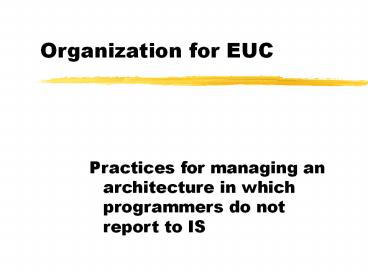Organization for EUC - PowerPoint PPT Presentation
Title:
Organization for EUC
Description:
Practices for managing an architecture in which programmers do not report to IS ... Gibson & Nolan, Managing the four stages of EDP growth, HBR, 1974 ... – PowerPoint PPT presentation
Number of Views:147
Avg rating:3.0/5.0
Title: Organization for EUC
1
Organization for EUC
- Practices for managing an architecture in which
programmers do not report to IS
2
Business Within a Business
- Most firms manage IT as a business within the
business, with IT having its own - career paths
- job descriptions
- personality profiles
3
Aligning IT with the Business
Technology Excellence (Systems)
IT
User
Business Profitability (Applications)
4
Organization Structures
- Contractor
- Formal agreements for services
- Utility
- Reliable information in standard form
- Vendor
- IS recommends solutions for business problems
- Partner
- IS and Line share responsibilities for success
5
Organizational Structures
Technology Need
Partner
Vendor
Utility
Contractor
Non technology need
6
Contractor
- The traditional organization for IS units in the
mainframe era. - Service level agreements
- Negotiated services
- Formal separation between users and technical
personnel
7
Contractor
IT
Business Users
Negotiation
8
Contractor
- Example outsourcing.
- While this model describes the internal
structure for many firms, it is the model for any
functions that are outsourced. (See Clermont,
Outsourcing without guilt, MoIS, 5.4).
9
UtilityHopper, HBR, 1990
- IS provides common interface among business
units. Common structure in client/server
architectures. - Is responsible for standard data or software
users responsible for business use. - IS monopoly
- Business units are the innovators
10
Utility
Business User
IT
Support
11
Utility
- Example cost centers.
- IS units set up as standard interfaces among
relatively independent business units.
12
VendorQuinn Paquette, Sloan MR, 1990
- IS competes with outside services for resources.
Acts as internal consultants. - IS responsible for understanding business tactics
- User accepts IS proposals
13
Vendor
Business User
IT
Sell
14
Vendor
- Example profit centers.
- Organizations that emulate consulting firms and
set up their IS organization as a separate profit
center do this. IS competes for funding dollars
against outside organizations. (See Allen,
Make IS pay its way, MoIS 5.7)
15
PartnerHenderson, Sloan MR, 1990
- IS tightly integrated with business strategy.
Most common in high tech businesses. - Users and IT consult on both technology and
business solutions - Shared rewards for business success or failure.
16
Partner
IT
Business User
Share
17
Partner
- Example distributed resources. Many companies
have distributed IT personnel into business units
so that the IT function would report directly to
the business unit manager.
18
Relationship Choice
- Contract
- Utility
- Vendor
- Partner
- The appropriate relationship depends on the
business strategy of the company, the maturity of
the organization and the experience with IT
19
Business Strategy
- Type A seeks to obtain business advantage from
the use of technology - Type B uses technology for business advantage,
although possibly not IT, and is comfortable
paying for quality - Type C seeks to compete on a commodity or cost
containment basis
20
Four Stages of EDP GrowthGibson Nolan,
Managing the four stages of EDP growth, HBR, 1974
- 1. Initiation new concept, exploring ways to
use the technology. No control. - 2. Expansion some applications found, need to
get people on board. - 3. Formalization costs become and issue.
Effective controls developed. - 4. Maturity technology well integrated and
managed.
21
Managerial Tactics
- Laissez Faire
- Monopolist
- Acceleration
- Marketing
- Operations
- Alavi, Nelson, Weiss, JMIS,
22
Organization Centralization, Decentralization
or Distribution
- Centralization
- Consolidation of functions
- Career paths for IS professionals
- Information control
- Economies of scale
23
Organization Centralization, Decentralization
or Distribution
- Decentralization
- Closeness to local problems
- Responsiveness to operational requirements
- User ownership of costs and problems
24
Organization Centralization, Decentralization
or Distribution
- Distribution
- Separation of IS and user functions
- Identification of corporate data and functions
- User ownership of user applications
25
People
- IT Motivational Profile
- Recruiting and Retention
- Teams and Projects
26
Rational Retention Strategies
- Recruit and Retain
- Recruit and Replace
- Outsource
- Entrepreneur Support
- Control and Limit
- Raid for experience
27
Reorganization Trends
- Outsourcing
- Purchased systems
- Core competencies
- Reengineering
- Downsizing and flattening
- Global competition
- Reduced margins
- TQM
28
Critical Success FactorsBoynton Zmud, An
assessment of critical success factors, HBR, 1984
- Those few things that must go well to ensure
success - Require continued monitoring
- Measurable
- Cover business requirements
29
IT
Business































